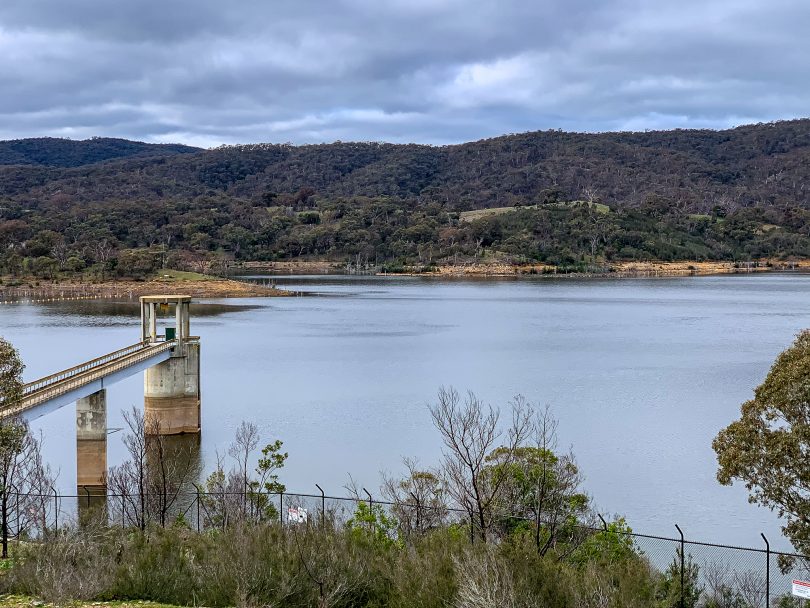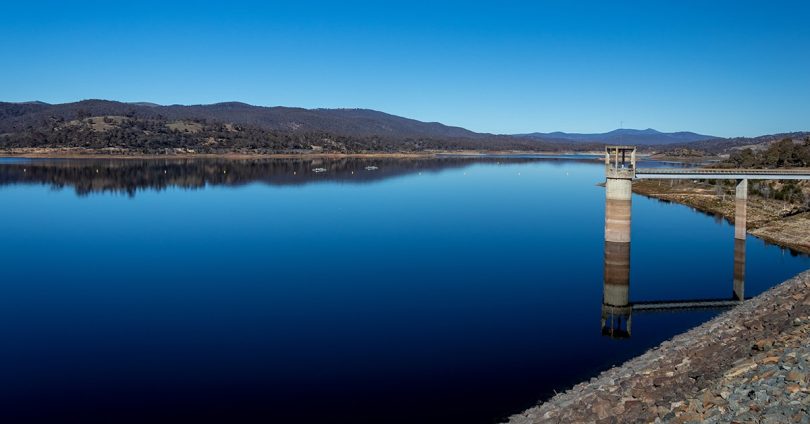
Googong Dam in August when it was at 60 per cent capacity. Photo: Icon Water.
Googong Dam will supply all water to residents of Canberra and Queanbeyan during November as one part of a strategy to address the rate at which the dam is increasing and to help to prevent a potential flood in Queanbeyan.
Googong Dam is currently 88.73 per cent full and rising. More than 5000 megalitres flowed into the dam in October, about 41 times more water than the same time last year when just over 129 megalitres flowed into the dam.
Daily consumption by the Canberra and Queanbeyan communities is currently 115.4 megalitres.
By way of comparison, an Olympic swimming pool holds 2.5 megalitres.
Icon Water’s general manager of infrastructure services Gerard Brierley said, based on modelling of current forecasts and predicted rainfall, there is a possibility that Googong Dam may reach capacity in the coming months.

Googong Dam in July when it was just over 47 per cent full. Photo: Icon Water.
Mr Brierley said Icon Water is well aware of what happened when much of Queanbeyan flooded in 2010, but Googong Dam could not prevent flooding in Queanbeyan, and that flooding would be worse if Googong Dam wasn’t there.
He said utilising the dam to supply all of Canberra and Queanbeyan’s water during November would help reduce the inflow into the dam. The switch to supply from Bendora and Googong dams solely to Googong is also occurring as Icon Water begins maintenance of the water treatment plant at Mt Stromlo on 4 November.
“As our dams reach capacity, water will naturally topple over the spillways. This is what is currently occurring at both Bendora and Cotter dams and will also occur when Googong reaches capacity. As water storage dams, all four of the ACT’s dams were designed to spill when at 100 per cent,” Mr Brierley told Region Media.
“Spilling does not, however, equate to flooding. Flooding, such as what occurred in Queanbeyan in 2010, was the result of a large rainfall event, and flooding would occur, with higher impact if the Googong Dam were not in place.”

Water spills over at Cotter Dam on 3 October. Photo: Michael Weaver.
Water from Googong Dam flows from the Queanbeyan River into the Molonglo River, upstream of Lake Burley Griffin. Once past Scrivener Dam in Canberra, the water then flows down the Molonglo, past the Lower Molonglo Water Quality Treatment Plant and into the Murrumbidgee River. The water then makes its way through rural land and into Burrinjuck Dam.
Recent rains have this week already closed the crossing between Oaks Estate and Pialligo, which is often the first to flood.
To avoid a repeat of the Queanbeyan flood of 2010, an independent study commissioned by Icon Water and Queanbeyan-Palerang Regional Council found Googong Dam reduced the peak of the flood by 47 per cent.
It also found the cost of flood mitigation measures far exceded that of damage caused by a potential flood.
During the 2010 flood, the report said, “the best-case scenario is that all of the $1.3 million in damage may have been avoided, although avoiding all of the damage costs is unlikely as some costs such as debris removal are likely to have been incurred even if the flood peak in Queanbeyan had been reduced”.
Construction work on Googong Dam was also done to strengthen the spillway and increase the height of the walls on each side of the spillway. The work made the spillway more capable of handling large floods but did not change Googong Dam’s performance during a normal flood, other than to make it less likely that a flood would damage the spillway.
Mr Brierley said the study clearly showed that if Icon Water had been running the dam at suggested levels of about 80 per cent, this would not have saved the flooding impact on Queanbeyan.
“Further to this, the report confirmed that it is unsustainable to use Googong Dam for flood mitigation and that the costs of operating Googong Dam at a lower level greatly outweighs any potential benefit,” he said.
“If Icon Water were to change the way that it manages the Googong Dam, then this would come with significant additional costs that would need to be borne by the Canberra and Queanbeyan communities.
“Although our dams are not flood mitigation dams, when they are full our dams can significantly reduce the risk of downstream flooding because water typically leaves the reservoir at a slower rate than it enters. This reduction in peak flow mitigates flood damage downstream,” Mr Brierley said.












